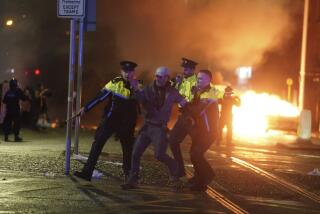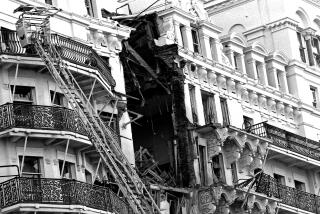Raid Ambush Seen as IRA’s Worst Defeat : Senior Activists, Unit Leaders Die in Attack on N. Ireland Police
- Share via
LOUGHGALL, Northern Ireland — An abortive armed attack on the police station in this quiet village, which cost the lives of eight activists of the outlawed Irish Republican Army, was acknowledged Saturday as the worst single defeat suffered by the IRA since the current guerrilla war began here nearly two decades ago.
The eight, including two regional IRA unit commanders, were killed Friday night when they drove an earthmover laden with explosives into the station’s perimeter fence and found themselves trapped in a British security forces ambush. A man driving his car in the area of the ambush was also killed in the exchange of small-arms fire, and a passenger in the car was critically wounded.
In numbers alone, the losses are seen as a significant blow to the IRA, which in recent years has waged its armed campaign against British rule in Northern Ireland with a limited number of small but well-trained units.
Those who monitor IRA activities estimate that the number of active members is probably around 250 in Northern Ireland, with a similar number in the Irish Republic.
The fact that several of the dead were experienced, senior members of the organization adds to the severity of the loss.
Active in Armagh Attacks
A police spokesman said those killed had all been active in guerrilla attacks in the area around the city of Armagh, about four miles east of here.
Gerry Adams, president of the IRA’s political wing, Sinn Fein, on Saturday called the incident “the single-biggest casualty since the Black-and-Tan War”--a reference to a series of clashes between the IRA and British Army irregulars after World War I.
“They were up against a better-armed enemy,” Adams said of Friday’s shoot-out. “Last night was unique in its tragedy.”
Saturday, a lone black flag hung outside the Sinn Fein headquarters in Belfast.
The battle at Loughgall, about 30 miles southwest of Belfast, constituted a rare, large-scale confrontation between the IRA and security forces in Northern Ireland, the six British-ruled Northern Irish counties known also as Ulster.
Intimidation and assassination rather than violent confrontation is the usual currency of the 18-year-old conflict between a Protestant majority wanting to retain British control and minority Roman Catholics, many of whom want Ulster integrated into a united, Catholic Ireland.
About 2,500 have died in fighting since 1969.
A statement issued Saturday by the IRA claimed that some of its members involved in the attack managed to shoot their way out of the ambush and escape, but a police spokesman in Belfast indicated only the eight dead men were involved.
IRA Claim Rejected
Police also firmly denied IRA claims that some of the casualties were killed only after having been captured.
In addition to its importance in military terms, the successful government ambush is also expected to have a significant impact on IRA morale.
After more than two years on the defensive and a major organizational shake-up last summer, the IRA earlier this year launched a new campaign of violence, which included the assassination of the province’s second-ranking judicial figure and nine police officers.
That campaign marked the first time that the security forces were placed on the defensive since Britain and the Irish Republic signed an agreement in November, 1985, to cooperate in reducing levels of violence in Ulster.
“The (IRA) has been on a high because of what it’s been able to do,” said John Cushnahan, leader of the province’s non-sectarian Alliance Party. “This is a big morale blow to them.”
Conversely, the ability to penetrate a disciplined IRA unit and spring a successful ambush has visibly lifted flagging spirits among the security forces.
Soldier, 2 Police Injured
Two police officers, members of the Royal Ulster Constabulary, and one British soldier were reportedly injured during the ambush.
British and Irish political leaders both blamed the IRA for the loss of life.
“People who attack police stations with arms must be prepared to face the consequences,” warned Tom King, Britain’s secretary of state for Northern Ireland.
Irish Foreign Minister Brian Lenihan said, “It was the IRA leadership (that is) responsible for putting those young lives at risk. It was a futile act of violence.”
Among the IRA dead were:
--Patrick Kelly, 26, said to be the commander of the IRA’s East Tyrone brigade.
--James Lynagh, 32, believed to be the IRA commander in the Irish Republic county of Monaghan, which borders Northern Ireland. He was wanted by British authorities for several murders, including the killing of James Stronge, former speaker of the Northern Ireland Parliament.
--Patrick McKearney, 32, jailed for 14 years in the late 1970s by British authorities for terrorist-related offenses. He was involved in a 1983 mass prison breakout and since then has been among the most-hunted members of the IRA.
Display of Weapons
On Saturday, police displayed an array of weapons, including high-powered rifles, a revolver and a pump-action shotgun that they said the IRA group carried in its attack.
The ambush occurred just before dark, as the IRA unit began its assault on the Loughgall police station.
British security forces refused to discuss details of the operation, but it is believed that at least four of the IRA attackers sprayed the station with small-arms fire as a fifth tried to drive the earthmover loaded with explosives through a protective fence that surrounded the station.
The explosion knocked the roof and one end off the police station, but by then British security forces deployed throughout the area had trapped the attackers and killed them in a withering cross-fire.
Police declined to say whether anyone was inside the police station at the time of attack.
Bullets from the battle went through windows of a nearby church hall where a group of village children had gathered, but none was injured.
Considered a ‘Soft’ Target
Ironically, the station at Loughgall seemed to have been chosen because it was a “soft” target. It was a minor station, open only a few hours daily, in a village virtually untouched in the long years of sectarian violence.
Many believe the IRA may now attempt to launch a quick, new operation to revive morale and regain momentum lost in Friday’s setback.
Security in Belfast and in other traditional trouble spots had visibly tightened Saturday.
A mortar round was lobbed into the grounds of a police station in Londonderry, but it did not explode.
More to Read
Sign up for Essential California
The most important California stories and recommendations in your inbox every morning.
You may occasionally receive promotional content from the Los Angeles Times.













